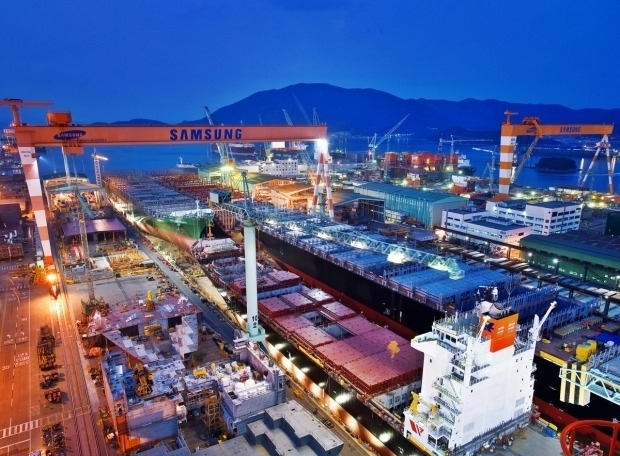Shipping & Shipbuilding
Korean shipbuilders tighten grip on ammonia carrier market
VLAC demand is forecast to soar on the growing use of ammonia as an eco-friendly fuel; Korean shipyards aim to expand market share
By Jan 19, 2024 (Gmt+09:00)
1
Min read
Most Read
LG Chem to sell water filter business to Glenwood PE for $692 million


Kyobo Life poised to buy Japan’s SBI Group-owned savings bank


KT&G eyes overseas M&A after rejecting activist fund's offer


StockX in merger talks with Naver’s online reseller Kream


Mirae Asset to be named Korea Post’s core real estate fund operator



South Korean shipbuilders continued to win very large ammonia carrier (VLAC) orders, expanding their shares in the global eco-friendly vessel market to improve their profitability.
HD Hyundai Heavy Industries Co., the world’s second-largest shipyard, said on Thursday it secured a deal worth 333 billion won ($249.4 million) to build two VLACs for a customer in Oceania. Its smaller rival Samsung Heavy Industries Co. also said it has bagged a 315 billion won contract to manufacture two liquefied petroleum and ammonia carriers.
Last week, HD Hyundai Heavy said it received a 317,3 billion won deal for two VLACs.
South Korea’s three major shipbuilders – the company’s parent HD Korea Shipbuilding & Offshore Engineering Co. (HD KSOE), Hanwha Ocean Co. and Samsung – secured deals to build 15 VLACs last year, 71% of total orders for the eco-friendly vessels.
“Domestic shipbuilders are expected to enjoy huge sales and profits by just maintaining the current market share in the global VLAC market,” said an industry source in Seoul. “We also have enough capacity to handle orders.”
SURGING DEMAND
The demand for VLACs is expected to significantly grow as ammonia is increasingly used as an eco-friendly energy source. The inorganic chemical compound of nitrogen and hydrogen does not contain carbon atoms and does not emit carbon dioxide when it is burned.
VLACs may be able to transport hydrogen as ammonia can be converted to hydrogen, industry sources said.
The world’s shipbuilders were forecast to enjoy orders to build some 120 VLACs on average a year in the next 20 years, according to analysis firms including Clarksons Research.
South Korean shipyards, which are turning to the black after years of losses, aim to take benefit from such strong demand.
The industry is also increasing investments in new VLAC technology. HD KSOE, HD Hyundai Group’s intermediate holding company for the shipbuilding business of subsidiaries such as HD Hyundai Heavy and Hyundai Mipo Dockyard Co., is working to develop an ammonia engine for VLAC by 2025.
Write to Sang Hoon Sung at uphoon@hankyung.com
Jongwoo Cheon edited this article.
More to Read
-
 Shipping & ShipbuildingHD KSOE wins $240 mn order for two ammonia carriers
Shipping & ShipbuildingHD KSOE wins $240 mn order for two ammonia carriersJan 08, 2024 (Gmt+09:00)
1 Min read -
 Shipping & ShipbuildingSamsung Heavy wins $240 mn order for two VLACs
Shipping & ShipbuildingSamsung Heavy wins $240 mn order for two VLACsDec 26, 2023 (Gmt+09:00)
1 Min read -
 Shipping & ShipbuildingKorean shipbuilders shrug off concerns over lower new ship prices
Shipping & ShipbuildingKorean shipbuilders shrug off concerns over lower new ship pricesDec 12, 2023 (Gmt+09:00)
2 Min read -
 Shipping & ShipbuildingHD KSOE secures $432 mn order for 4 ammonia carriers
Shipping & ShipbuildingHD KSOE secures $432 mn order for 4 ammonia carriersDec 01, 2023 (Gmt+09:00)
1 Min read -
 Shipping & ShipbuildingHanwha Ocean wins $125.5 mn order for VLAC
Shipping & ShipbuildingHanwha Ocean wins $125.5 mn order for VLACNov 27, 2023 (Gmt+09:00)
1 Min read
Comment 0
LOG IN


